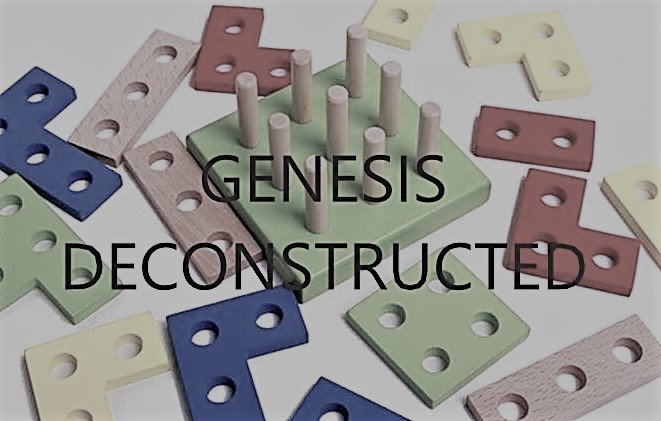In the table below, we see the names/titles used of the male and female Adam before the separation of the female from the male in Gen 2:5 to 2:22, after the separation in Gen 2:23 to 4:1, and prophesying their reunification in Gen 1:26 & 27.
The translation of the names/titles used of Adam in the Genesis creation account is inconsistent and illogical. There are different translations of the same word, and the same translation of different words, obviously done to support the traditional account that the female was made from the male, for the male and to cover up the corruption of the male. For example:
- In the Hebrew Bible, Adam and ha–Adam are translated as either the general term ‘man’ or the specific name ‘Adam’, and ish איש in Gen 2:23, 24 & 4:1 is translated ‘man’, but in Gen 3:16 as ‘husband’.
- In the Targum Onkelos (TO), instead of Adam in Gen 1:26 & 2:5, we find anash אינש (with an aleph suffix in Gen 1:26), translated ‘man’ in both cases. Instead of ish איש in Gen 2:23 & 3:16, we find baal בעל, translated ‘man’ and ‘husband’ in the TO, just like the HB. Instead of ish איש in Gen 2:24 & 4:1, we find geber גבר , translated ‘husband’ and ‘man’ respectively in both the HB and TO.
- In the Samaritan Targum (ST), instead of Adam אדם in Gen 2:5 and ha–Adam האדם in Gen 2:7 (2nd) & 18, we find anash אנש , translated as ‘man’ in the ST, and in Gen 2:5 & 7 of the HB, but Gen 2:18 is translated ‘Adam’. Instead of of ish איש in Gen 2:23, 24, 3:16, & 4:1 we find geber גבר translated as ‘husband’, ‘man’, and ‘husband’ respectively (Gen 4:1 is not translated), unlike the HB where Gen 2:23, 24, & 4:1 are translated ‘man’, and Gen 3:16 is translated ‘husband’.
The names/titles used of Adam have different meanings, and indicate changes in his physical characteristics and disposition.
Before the separation of the female from the male in Gen 2:22, the name/title/race adam אדם (Strong’s 120) means ‘a human being, common person’, or ‘to be red’, that is “from the same as” adamah אדמה (Strong’s 127) that means ‘ground, land, soil’ (see Fact #35), which described the male/female adam as dust/dirt. Instead of Adam, the Targum’s in Gen 2:5, and the ST in Gen 2:7 (2nd occurrence) and 2:18, have anash (Strong’s 605), in the form אינש in the TO and אנש in the ST, that means ‘to be weak, sick’. In Fuerst’s Lexicon p. 125, anash אנש means ‘to be sick i.e. morally bad, ill, figuratively painful, dangerous’. This provides critical information about the state of mankind when he/she was made from the ground.
After the separation, in Gen 2:23, 24, 3:16 & 4:1 the male is identified as an ish איש in the HB, a baal בעל and geber גבר in the TO, and a geber גבר in the ST. This reveals that ish, baal and geber have a common meaning, which Rashi confirmed in Exodus 15:3 when he said “Wherever the words איש and אישך occur they must be translated by בעל; so, too, (1 Kings 2:2) ‘Be thou strong and show thyself an איש’ — a mighty person.” This is confirmed in Fuerst’s Lexicon p. 77, 1st – plural אישי or אנש, ‘strong’ from esh אש and אשש , like/from geber גבר. In Fuerst’s Lexicon p. 222-5, Baal בעל means, 1st – ‘to be big, mighty, strong, master, lord’, 2nd – ‘lords of the heathen i.e. their conquerors’, and geber גבר on p. 260 – 1, 1st ‘to be strong, powerful, capable of bearing arms, to conquer, to swell up, to get influence’, 2nd – ‘a valiant soldier, a warrior, a man of strength, particularly in opposition to God, and therefore like איש in the sense of one, every one’.
The sixth creation day in Gen 1:26 – 31, prophecies Yahshua’s incarnation in the flesh, described in John 1:14. In the HB and ST, gods say “We will make adam in our image, in our likeness . . .”, but instead of adam, the TO has anash אינש, that means to be sick i.e. morally bad, ill, figuratively painful, dangerous. In Gen 1:27, the ‘sick’ adam is replaced by the perfect male, Yahshua, reunited with the female, and adam is now re-created in the image of gods. This is the wedding feast of Yahweh’s son, to which only those with wedding clothes are permitted entry in Matthew 22: 1 – 14.
The message of the Genesis creation account is largely revealed in the changing names/titles for adam. When adam became sick (corrupt), the female was separated from the male to save her, as Yahweh said in Gen 2:18. The male assumed the name adam after the separation, and the female’s name became ishshah. Adam identified himself as a mighty one (ish) in Gen 2:23. He was Assyria who had become ‘lofty, exalted’ (Strong’s 1361 gabahh גבהא that we see in Fact #120 figuratively means ‘toward a ditch’) as revealed in Ezek 31: 3 – 5.
Discover more from Genesis Deconstructed
Subscribe to get the latest posts sent to your email.
